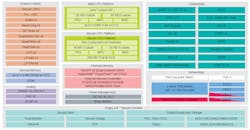This article is part of TechXchange: Time for Time-Sensitive Networking
NXP Semiconductors rolled out a family of high-performance microcontrollers that integrates a gigabit-per-second, time-sensitive networking (TSN) switch, in a bid to expand its footprint in the industrial Internet of Things (IIoT).
The new i.MX RT1180 is the latest in the company’s i.MX RT series of high-performance crossover MCUs.
With up to five Gb/s Ethernet ports, NXP said the i.MX RT1180 MCU supports a wide range of networking protocols for industrial communications, including the latest TSN Ethernet standards, as well as real-time legacy protocols such as EtherCAT, Profinet, Ethernet/IP, and CC-Link, among others. The company said the i.MX RT1180 takes the place of a standalone Ethernet switch, saving board space and reducing costs.
TSN is a set of networking standards that bring deterministic real-time communication to factory floors and industrial systems. It provides a shared understanding of time to sensors and other devices so they can connect safely with each other over Ethernet, supplementing many of the legacy protocols in use today. With TSN, information (IT) and operational technology (OT) can both run on the same network.
Networking Event
According to NXP, the i.MX RT1180 is the first in its i.MX RT family to incorporate its EdgeLock secure enclave. NXP said EdgeLock eases the challenge of implementing robust security and intelligence in IIoT devices.
The secure enclave acts as a root of trust with secure boot. It can handle authentication, secure management of the device throughout its lifecycle, and advanced key management for the IIoT.
The modern factory floor is becoming more automated, creating a complex web of networking protocols. “Industrial and automotive customers are looking to provide increasingly advanced network capabilities and need a solution that not only provides processing power, but can also manage time-sensitive network traffic,” said Jeff Steinheider, NXP’s vice president and general manager of industrial edge processing.
Furthermore, the i.MX RT1180 can be used as a networking switch between cars' electronic control units (ECUs). Today, cars rely increasingly on Ethernet TSN for both high-bandwidth and real-time control.
NXP is trying to take a larger slice of the market for high-performance MCUs with the reliability and rigor required for modern factories. It is competing with the likes of Texas Instruments and STMicroelectronics.
Last year, TI rolled out a series of industrial-grade microprocessors, the AM243x, which integrates real-time Cortex-R5 and Cortex-M4 CPUs with a wide range of networking accelerators and Gb/s Ethernet.
800-MHz MCU + SRAM
The i.MX RT1180, based on a dual-core architecture, tolerates a temperature range of −40 to 125°C. A high-performance Cortex-M7 clocked at 800 MHz is paired with a high-efficiency, 240-MHz Cortex-M33, which runs within a completely independent, secure domain. The memory subsystem of the chip adds a large 1.5-MB block of SRAM, along with 512 kB of cache in the Cortex-M7 and 256 kB in the Cortex-M33.
NXP said the i.MX RT1180 comes housed in a 10- x 10-mm or 14- x 14-mm BGA package. The compact footprint makes it easy to integrate with motor-control systems, industrial gateways, and other equipment.
The microcontroller is also loaded with peripherals, said NXP. They include 12x UART, 3x I3C, 6x I2C, 6x LPSPI, 2x FlexIO, 2x USB Gen 2 OTG, 3x CAN FD, and dual 16-bit analog-to-digital converters (ADCs).
NXP plans to roll out a suite of system configuration tools, an open-source software development kit (SDK), and an integrated development environment (IDE) to make it easier for customers to deploy software on the i.MX RT1180.
Read more articles in TechXchange: Time for Time-Sensitive Networking


